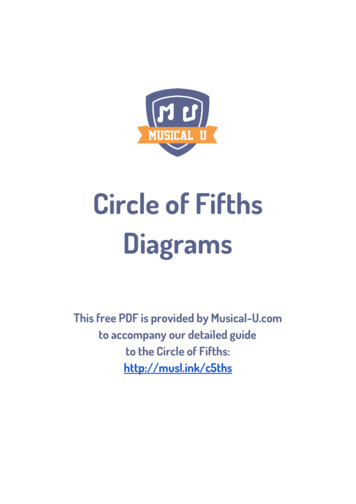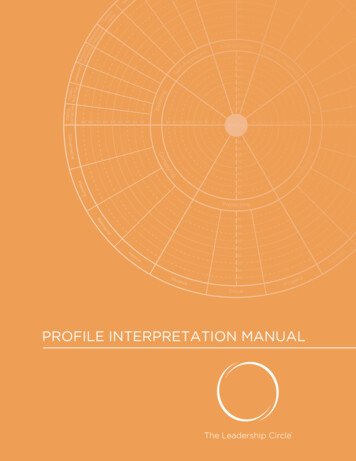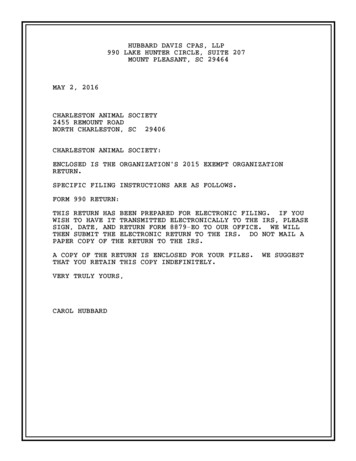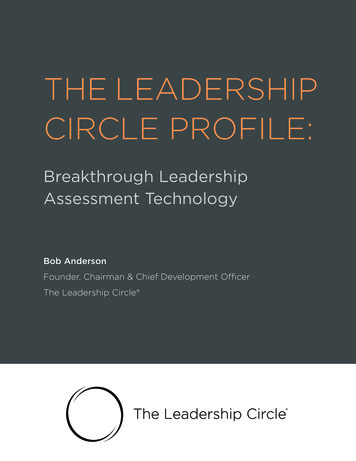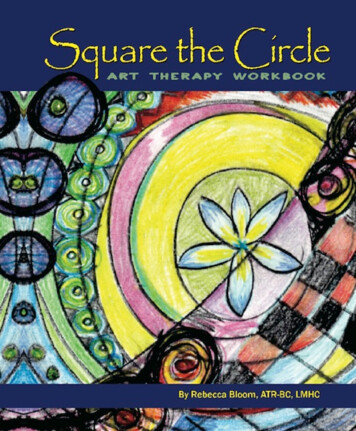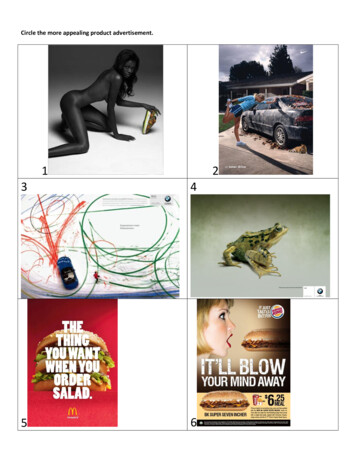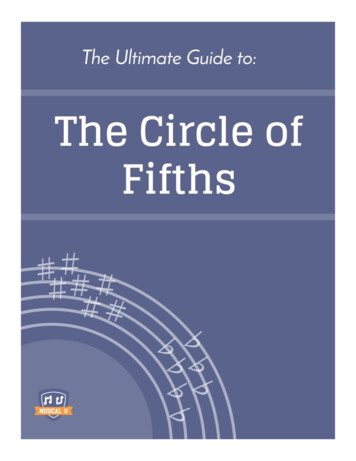
Transcription
The Circle of Fifths is a mystery to many. But what if you foundeverything you ever needed to know and learn about musicalpitch (every note, scale, chord, progressions, etc.) in a simplediagram that could fit in the palm of your hand?The Circle of Fifths is that magical musical master tool.This learning device has endured for hundreds of years since itsinvention, and for good reason; there’s no need to reinvent the wheel.Or, apparently, any other circular entity.This incredibly powerful tool will take you far beyond simplyunderstanding music theory - it will help you write music, predictchords in a progression, and understand relationships between majorand minor keys.Is the Circle of Fifths for You?Though the Circle of Fifths is most commonly understood as acomponent of classical music theory, it’s certainly not only for thehallowed halls of the conservatory. It’s a valuable tool for any musicianof any musical background.Our guide is the Circle of Fifths made easy – very little prior musicalknowledge is required, but by the end of this article, you’ll not onlyunderstand the mechanics behind the circle, but also how to apply it inmusic theory, transposition, singing, songwriting, and more.This incredibly powerful tool will take you far beyond simplyunderstanding music theory – it will help you write music, predictchords in a progression, and understand relationships between majorand minor keys. It will serve you well, regardless of whether you are aclassical violinist, jazz saxophone player, a bassist in a rock band, oraspiring DJ.1 Copyright Musical U, https://www.musical-u.com/
So fasten your seatbelt: we’re diving deep into this infinite pool ofmusical wisdom.So, here is the Circle of Fifths, explained.2 Copyright Musical U, https://www.musical-u.com/
TABLE OF CONTENTSIs the Circle of Fifths for You?1The Circle’s BeginningsLet’s Start With Some Theory.The Keys to What?What’s a Fifth?Build Your Own Perfection:45568Introducing. The Circle of Fifths!The Bare BonesFiguring Out Key SignaturesSidebar: Where Things Get A Bit Tricky.What About Minor Keys?Also Known As Modes and the Circle of Fifths10101214151717How to Use the Circle of FifthsUsing the Circle of Fifths to find Key SignaturesUsing the Circle of Fifths to Build ScalesRead scales right off the CircleUsing the Circle of Fifths to Build ChordsMajor and Minor ChordsDominant Seventh ChordsUsing the Circle of Fifths to Play Chord Progressions By Ear2020212122222630The Circle of Fifths for SongwritersCrossing the CircleBeyond Major.323434The Key that Unlocks the World of Western Music353 Copyright Musical U, https://www.musical-u.com/
The Circle’s BeginningsSo, how was the Circle of Fifths invented, and who is responsible forthe discovery of this musical godsend?Russian composer and music theorist Nikolay Diletsky set this wholewheel rolling in the late 1670’s. He intended his book Grammatika as aguide to composition, but with the rules of music theory in mind:4 Copyright Musical U, https://www.musical-u.com/
Since then, it has been expanded and improved-upon to yield thecomprehensive circular diagram we have today.Let’s Start With Some Theory.Before we dive into the mechanics of the circle, let’s first understandsome key concepts. Bear with us - this basic music theory will be ahuge help in making sense of the circle.Each “station” on the circle represents a note , a chord , and akey .The Keys to What?Let’s begin by answering the question: What’s a key?In music, we define a key as the “tonal center” of a piece of music.The melody and harmony will revolve around this tonal center, whichis simply a single note. This single note is also given the name of thetonic , and is given the scale degree designation “I” .It is on this tonic that we build the scale , or the eight-note sequencethat is used to compose melodies and harmonies in the key of thetonic.The most commonly-encountered types of scales in Western music arecalled “major” and “minor”. To retain the characteristic major or minorsound, scales in most keys require accidentals - sharps and flats thatwill give the scale the desired sound.5 Copyright Musical U, https://www.musical-u.com/
Each key will have its unique pattern of sharps and flats. However, ifyou examine the distances (known as “ intervals”) between the notesof, say, every major scale and compare them, you will see that theinterval pattern is exactly the same in all major scales. Learn more about i ntervals .What’s a Fifth?One of these “shared” intervals will be a fifth (also known as a perfectfifth ).So what’s so “perfect” about a fifth?Perfect intervals vibrate in pure mathematical ratios. For example, thisnote (A) is vibrating at 440 Hz (cycles per second):LISTEN ONLINEAnd this “A” is vibrating twice as fast, at 880 Hz:LISTEN ONLINEWe call this interval a “perfect octave”. Octaves relate to each other insome multiple of a 2:1 ratio. Octaves are so “perfect” that, whenplayed together, the notes blend together until it’s difficult to tell onefrom the other:6 Copyright Musical U, https://www.musical-u.com/
LISTEN ONLINEThe next smallest simple ratio is 3:2:LISTEN ONLINEYou can hear that the fifth also blends very well, and has a powerful,resonant sound (which is how the famous guitar “power chords” work.)So when you put your finger on the 12th fret of a guitar, you’resplitting that string in half (2:1 ratio). To produce the fifth, divide thestring in three parts (7th fret).The perfect fifth interval is said to be consonant , meaning it is a typical“pleasant sound” and sounds stable within music. The fifth of a keycan be found by finding the fifth degree of the scale of the key.If you are familiar with tones and semitones, the fifth can be found bycounting seven semitones up . Starting at the tonic, this is sevenadjacent keys (this includes black keys!) on piano, or seven frets upon the guitar, bass, and ukulele.Playing a fretless string instrument? Have no fear! The Circle of Fifthsalso applies to the violin and its immediate family of instruments.The fifth shows up frequently in basslines of Western music, withroot-fifth patterns being a popular choice for bassists. Why?7 Copyright Musical U, https://www.musical-u.com/
The perfect fifth interval sounds consonant and stable, thereby helpingthe bassist fulfill their role of “supporting” the song; the patterns ofthis interval sound great under guitar chords. Best of all, it’s a fairlystraightforward pattern to memorize and it’s easy to play!Build Your Own Perfection:Now that you have a good idea of what a fifth is, it’s time to build yourown circle! Print out the following free Circle of Fifths PDF worksheet.(You can use it for teaching the Circle of Fifths as s/2017/07/Free-Circleof-Fifths-Worksheets.pdf8 Copyright Musical U, https://www.musical-u.com/
Now count up the C scale five notes:9 Copyright Musical U, https://www.musical-u.com/
Write the “G” in at one o’clock. G then becomes the new tonic. Makesure that you are adding in the appropriate sharps or flats for eachnew tonic center as you continue around the circle. If you’re fuzzy onyour key signatures you can look them up, or count your fifths inhalf-steps (semitones) - remember, a perfect fifth seven semitones.How did it come out? Check your work with the diagram below.Introducing. The Circle of Fifths!By definition, the Circle of Fifths is a visual tool designed to illustratethe relationships between the 12 tones of the chromatic scale - thefoundation on which Western music is built.The name derives from the fact that going clockwise around the circle,each note is a fifth (a perfect fifth, to be exact) above the previousone in the circle.The result? This unassuming circle shows how all the musical notes,keys, and chords relate to each other. Let’s explore how the circle isbuilt, starting with the absolute basics.The Bare BonesLet’s first look at the most simple iteration of the circle:10 Copyright Musical U, https://www.musical-u.com/
Starting with the note of C at 12 o’clock and moving clockwise aroundthe circle, each new note is a perfect fifth above the previous one,eventually coming back to C. The whole Circle of Fifths progression issimply perfect fifths stacked on top of each other, eventually comingback to C from F.Here is where it gets interesting: the letters around the circle aren’tjust note names - they also represent the corresponding key of each11 Copyright Musical U, https://www.musical-u.com/
note. Therefore, we are starting with the accidental-free key of Cmajor at the top of the circle, and working our way around throughkeys with accidentals in them.Figuring Out Key SignaturesHere’s the circle with the corresponding key signatures of each majorkey represented:Imagine the Circle of Fifths as the keys on the piano twisted into acircle. Middle C is at the very top, where 12 on a clock would be. Why12 Copyright Musical U, https://www.musical-u.com/
is it at the top? Because C major has no sharps or flats so it is almostlike a “neutral” key.While the diagram may initially appear overwhelming, fear not! Theaddition of sharps and flats not only follows a predictable pattern whengoing around the circle, but the direction you’re heading in tells youwhether you’re adding sharps or flats. Remember: no key signaturehas both sharps and flats.Head clockwise around the circle starting at C major. G major has onesharp (F ), D major two (F , C ) and so on. Soon you’ll notice thatnew sharps are added in the order F-C-G-D-A-E-B.Head counterclockwise around the circle starting at C major, and you’llsee that flats are added in the reverse order: B-E-A-D-G-C-F.Making your life easier still: the number of steps you take aroundthe circle tells you how many accidentals the key will have. Ifyou’re trying to figure out the number of sharps B major has, countthe five steps around the circle to determine that it will have five. Theletter sequence will tell you that its sharps are F , C , G , D , andA .If you want to memorize one thing in music, this sequence of lettersshould be it! A useful (and heartwarming) mnemonic for this Circle ofFifths pattern is “Father Christmas Gave Dad An Electric Blanket”.13 Copyright Musical U, https://www.musical-u.com/
Come up with your own creative one in reverse for remembering theorder of flats!Sidebar: Where Things Get A Bit Tricky.The letter sequence F-C-G-D-A-E-B may end up confusing you if youlook at the circle and realize that there’s no E or B anywhere onthe key signatures of the circle.And you’re absolutely right. E would be F major and B would be Cmajor.But remember, we’re counting sharps from G, so once once we get toseven sharps (and every note is therefore sharpened), it actuallybecomes far easier to think of the scale in terms of flats , becausethere will be less accidentals!This is where the concept of enharmonic equivalence comes in; C major will be identical to D major, and if you represent the pitches inthe C major scale (with every degree being sharpened) in terms offlats and naturals instead of sharps only, you get the five-flat keysignature of D major.14 Copyright Musical U, https://www.musical-u.com/
In our chart, G , D , and A are included because they sometimescome up as useful chords (thanks mostly to guitarists, who tend to likesharps more than flats) - but E and B would be rare exotic beastsfor any instrument.What About Minor Keys?So far, the circle we’ve presented to you has only contained majorkeys and their key signatures. The good news is, you don’t have to15 Copyright Musical U, https://www.musical-u.com/
construct a second circle for the minor keys! You can fit them rightinto the circle by following the rules of relative minors:A quick refresher: the relative minor of a key has the same keysignature, and therefore all the same notes, as the major.Here are two ways to quickly find the relative minor of a major key:16 Copyright Musical U, https://www.musical-u.com/
1. Work out the major scale on paper or on your instrument. Therelative minor tonic will be on the sixth degree of the scale. Interms of intervals that’s a major sixth up or a minor third down.2. Using the Circle of Fifths, simply move three positions clockwisearound the to find the relative minor! So, starting from C, count1 (G), 2 (D) and then 3: A is your relative minor.If you’re paying really close attention, you’ll notice that the relativeminors going clockwise around the circle are also a fifth apart!Also Known As The reason for naming it the Circle of Fifths should be fairly obvious bynow: adjacent keys of both the major and minor quality are separatedby an interval of a perfect fifth.However, there is another way to think about all this.You may have heard of something in music called the Circle (or“Cycle”) of Fourths. Good news: this and the Circle of Fifths arenot two separate concepts, but two different names for theexact same thing!The Circle of Fifths can alternately be named the Circle of Fourthsbecause if you decide to go counterclockwise around the circle, eachnote is a fourth above the previous one.Both names are equally “right”, and you’ll find that both are used inreference to the circle.Modes and the Circle of FifthsBefore we jump into the numerous uses of the Circle of Fifths, let’scheck out how it relates to musical modes. For the uninitiated or forthose wanting a refresher, check out our introduction to modalimprovisation .17 Copyright Musical U, https://www.musical-u.com/
If you squish any seven adjacent notes in the Circle down to a scale,you wind up with the Lydian mode , rather than the major scale:Compared with the major scale, the Lydian mode is distinctive in itsfloaty, perpetually unresolved demeanor. Its notes give it an almostmagical quality.Keep going, and you get a full chromatic scale.Jazz the
pitch (every note, scale, chord, progressions, etc.) in a simple diagram that could fit in the palm of your hand? The Circle of Fifths is that magical musical master tool. This learning device has endured for hundreds of years since its invention, and for good reason; there’s no need to reinvent the wheel. Or, apparently, any other circular entity. This incredibly powerful tool will take you .
